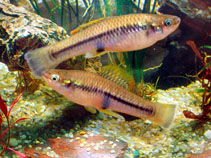| Family: |
Poeciliidae (Poeciliids), subfamily: Poeciliinae |
| Max. size: |
6 cm SL (male/unsexed); 3.4 cm SL (female) |
| Environment: |
pelagic; freshwater, non-migratory |
| Distribution: |
Central America: Costa Rica. |
| Diagnosis: |
The 10 dark bars on the sides of the body are more pronounced in males. The population in the headwaters of Río Virilla near Santa Ana and Villa Colón are larger and most individuals lack the vertical bars. Interradial membranes on the base of the dorsal fin and the rays are jet black; distal half of the fin yellowish or orange and the margin is black in both sexes. Anal fin is yellow or yellow-orange and has a black blotch from the base to the tip of the fin. Pelvic fins yellowish and caudal distal margin often brilliant yellow (Ref. 36880). |
| Biology: |
An insectivorous fish generally inhabits waters of low to moderate current velocity; between 10 and 900 m elevation; at temperatures of 19 to 34°C; in surface or midwaters of brooks, streams. Occasionally found in shallow waters of rivers (Ref. 36880). |
| IUCN Red List Status: |
Data deficient (DD); Date assessed: 31 December 2019 Ref. (130435)
|
| Threat to humans: |
harmless |
Source and more info: www.fishbase.org. For personal, classroom, and other internal use only. Not for publication.

